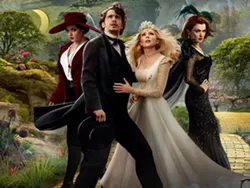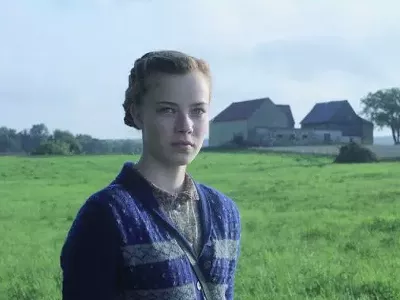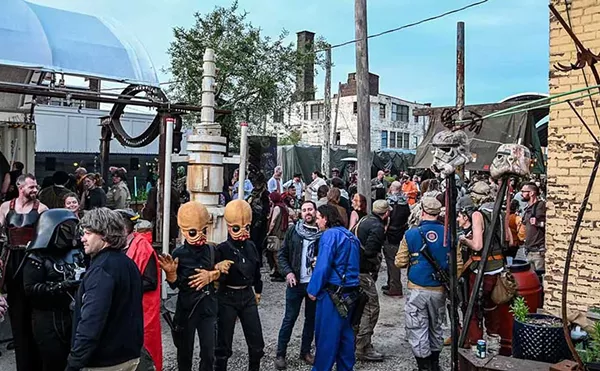Film Review: Oz the Great and Powerful
Maybe Kansas ain’t so bad? Not long into this Oz prequel, you’ll be wanting for your own ruby slippers.

Audio By Carbonatix
[
{
"name": "GPT - Leaderboard - Inline - Content",
"component": "35519556",
"insertPoint": "5th",
"startingPoint": "3",
"requiredCountToDisplay": "3",
"maxInsertions": 100,
"adList": [
{
"adPreset": "LeaderboardInline"
}
]
}
]

Oz the Great and Powerful | C+
Please make it stop. Since the billion-dollar success of Tim Burton’s Alice in Wonderland, Hollywood has been churning out retooled fairy tale blockbusters at a furious rate, and most can’t escape the economic, rather than artistic, calculus behind their creation.
Red Riding Hood, two Snow Whites, Hansel and Gretel, and Jack and the Beanstalk have already come and gone. Re-imaginings of Pinocchio, Peter Pan, Sinbad and Ali Baba (teamed together buddy-cop style), and Sleeping Beauty’s Maleficent (starring Angelina Jolie) are on the way. Each will probably have the shelf life of the latest Gagnam Style/Harlem Shake dance craze.
Compared to last week’s release of the relentlessly bland and utterly disposable Jack the Giant Slayer, I guess director Sam Raimi’s kinda, sorta, prequel to The Wizard of Oz (though no one associated with the film would call it that for fear of inciting Warner’s sue-happy lawyers) is an improvement.
A kitschy and colorful family concoction, Oz the Great and Powerful does benefit from Raimi’s stylistic choices, and a solid cast, but suffers from Disney’s ferocious corporate need to force all artistic choices toward maximal demographic, merchandising and box office grossing potential.
After a wonderfully inspired opening credit sequence that takes vintage set designs and turns them into 3-D eye candy, Raimi deposits us into sepia-toned, 1.33 ratio Kansas, where sideshow magician Oscar “Oz” Diggs (James Franco) tries to extract a few dollars from the local rubes. Self-absorbed, convinced he was meant for great things and an unabashed womanizer, the quick-mouthed conman quickly runs afoul of the carnival strongman and escapes in his hot air balloon — just as a spectacular tornado touches down.
It’s at this point where Raimi really struts his slaphappy stuff, twisting and twirling Franco through a whirling obstacle course of sharp-edged debris and snapping ropes. The 3-D pops with ferocious whip pans and eye-popping POV shots, culminating with a sudden and gentle drift into the hyper-saturated land of Oz, where widescreen color makes the most of its candy-hued CGI landscape.
You’d think that Mitchell Kapner and David Lindsay-Abaire’s script would take the wild energy of that transition to fashion a story that soars with imagination. You’d be wrong.
Instead, we’re introduced to a winsome exposition-spouting witch named Theodora (Mila Kunis) and, eventually, her scheming sister Evanora (Rachel Weisz). As the story goes, it was prophesied that a wizard would come to rescue the kingdom from the wicked witch and become ruler of the Emerald City. This sounds like a good deal to Oz once he gets a peek at the treasure room. Teamed with a flying monkey butler (voiced by Zach Braff) and a sweetie-pie porcelain doll (voiced by Joey King), the would-be wizard quickly discovers that he’s been duped by Evanora and ends up joining Glinda, the Good Witch (Michelle Williams), and her army of peace-loving tinkers, farmers and munchkins.
When it comes right down to it, Oz the Great and Powerful is just another origin movie, much like the superhero flicks currently dominating the summer schedule. Not only do we learn how the wizard became the leader of Oz but why the Wicked Witch is so damn wicked. Ho-hum.
The cast has its moments but are mostly overwhelmed (and embarrassed) by the Disneyfied extravagances surrounding them. Williams and Weisz handle things best, bringing spice to the two sides of their witchy coin. Glinda, for all her sweetness, radiates some surprising sexuality, and Evanora makes good use of her dark-eyed seductiveness to emit real danger. Kunis struggles with her innocent but underwritten Theodora, finding firmer footing in the movie’s second half.
Franco, however, seems miscast. He handles the humor well enough, but when the script calls upon him to deviate and be a smooth-talking showman, manipulative cad, or conscientious hero, he stumbles. As an endearing scoundrel he just doesn’t have the playful egotism of a Johnny Depp or Robert Downey Jr.; and the script’s clumsy dialogue does him no favors.
If Oz the Great and Powerful has any thematic resonance, I suppose it could be construed as a riff on the grand illusion of movies and the way their stories convince through visual sleight-of-hand.
Raimi’s big action finale is literally built around the power of smoke and mirrors, suggesting that the projected image is indeed magical, able to win wars and change hearts. It’s a lovely (if self-serving) sentiment that’s unfortunately undermined by the lack of originality and invention that permeates the rest of the film. In the end, those effects, like the script’s spin on Frank L. Baum’s world, feels less like a nostalgic homage and more like an elaborately staged grave robbing.
Despite this native son’s attempt to give his movie some cinematic panache (Raimi is from Royal Oak), Oz remains a calculated studio endeavor, filled with awkward shifts between simple-minded humor, gooey sentimentality, lavish effect sequences and move-it-along storytelling.





